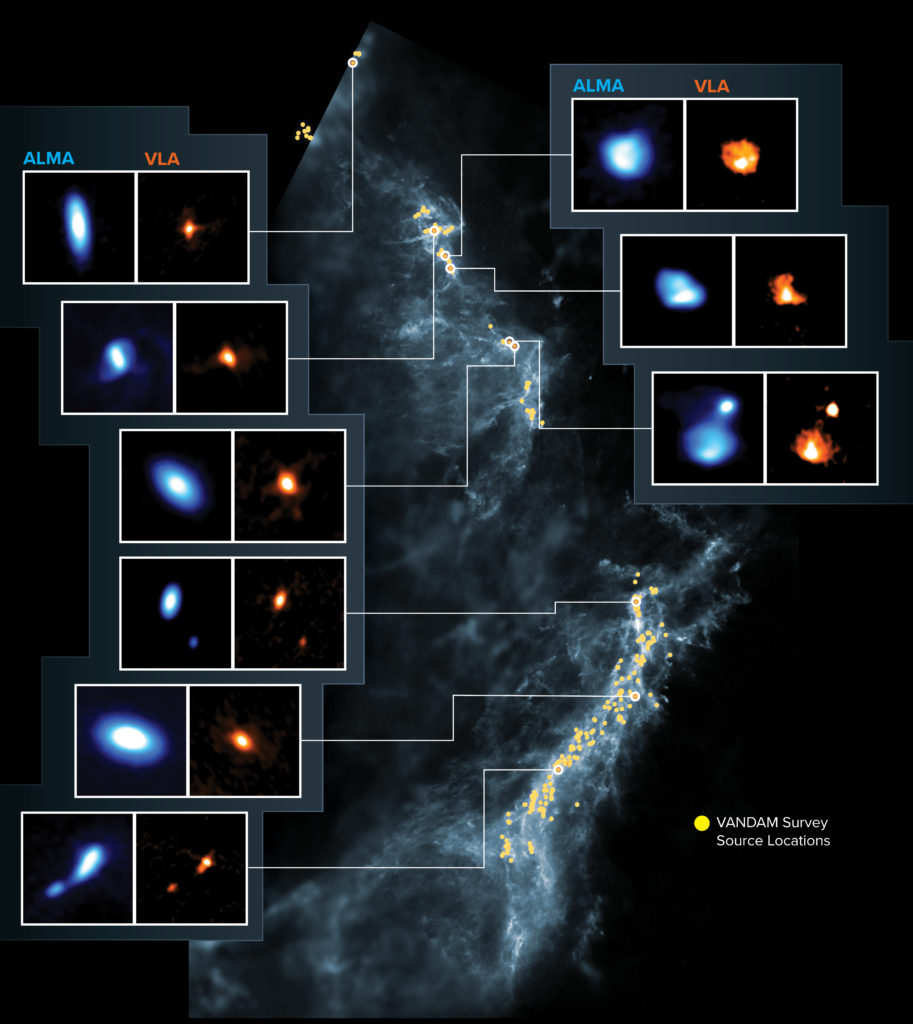This database compiles the continuum images of disks and jets detected by the VLA/ALMA Nascent Disk and Multiplicity (VANDAM) Survey of Orion Protostars (Tobin et al. 2020). The survey covers the Orion regions: OMC-1/ONC, OMC-2, OMC-3, NGC 2068, LDN 1641 by observing 328 protostars with ALMA at 870 micron with an angular resolution of ~0.1" (40 au) and 148 protostars with the VLA at 9 mm reaching an angular resolution of ~0.08" (32 au). The ALMA integration time on source was ~1 minute.
Each ~1" field is centered on a source previously detected in the far-infrared range by the Herschel Orion Protostar Survey (HOPS) consortium, which is led by Tom Megeath (Toledo University, USA).
These sources, named as HOPS sources (see also IRSA infrared catalog), are in different evolutionary stages of the protostellar evolution, i.e. Class 0, Class I, Class II and flat spectrum sources. This classification was performed by Furlan et al. (2016) based on the bolometric luminosity and temperature. The fundamental physical properties of the sources, such as, luminosity, envelope mass, inclination of the system, density, extinction, cavity angle, etc., are also listed in Furlan et al. (2016). But flux density in the sub-millimeter and millimeter range, positions, sizes, spectral indices, disk masses, the Q-parameter related with the stability of the disk, etc, are obtained from Tobin et al. (2020) and given in this catalog.
The protostars were also observed using the Atacama Compact Array (ACA) at 870 micron with an angular resolution of 4'' (1600 au) to measure the flux densities of the disks and their envelopes (Federman et al. 2022).
The catalog also includes the images of the sources detected by Osorio et al. (2017) and Díaz-Rogríguez et al. (to be submitted) in OMC-2 region that are associated with thermal and non-thermal jets, knots, possible photoevaporating disks of HOPS sources as well as new sources, named as Source 1, 2, 3, etc, and extragalactic sources that have been discovered in this region. The observations were conducted with the VLA in the 0.7 mm, 1.3, 3 and 5 cm bands and with an angular resolution ranging from ~0.1" to 4".
Targets can be found by searching by their HOPS name (e.g. HOPS-40) or by coordinates looking at the list of available declinations and right ascensions. The fits files for each field observed with ALMA and the VLA are also included (click here).

Credits: ALMA (ESO/NAOJ/NRAO), J. Tobin; NRAO/AUI/NSF, S. Dagnello.
